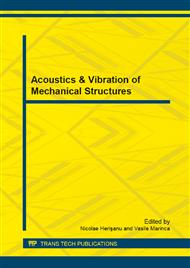p.317
p.323
p.329
p.335
p.342
p.351
p.356
p.362
p.367
Theoretical and Experimental Studies on Magnetic Dampers
Abstract:
The proper operation and reliability of numerous mechanical devices depends on reducing the vibrations of embedded components, modeled as multi-degree-of-freedom dynamic systems. This can be achieved by using various types of absorbers. The design of such devices is conditioned by the understanding of the variation of their technical characteristics with the constructive parameters. The present paper is dedicated to a special type of dampers, based on the use of the magnetic phenomenon. However, available empirical formulae for the damping characteristics of magnetic dampers do not reveal all significant dependencies. Based on theoretical, numerical and experimental methods, the paper brings a number of contributions concerning the relation between the damping characteristics of a magnetic damper and some of its constructive parameters. Variation curves, useful both for theoretical studies and practical applications, are plotted.
Info:
Periodical:
Pages:
351-355
Citation:
Online since:
September 2013
Keywords:
Price:
Сopyright:
© 2013 Trans Tech Publications Ltd. All Rights Reserved
Share:
Citation:


